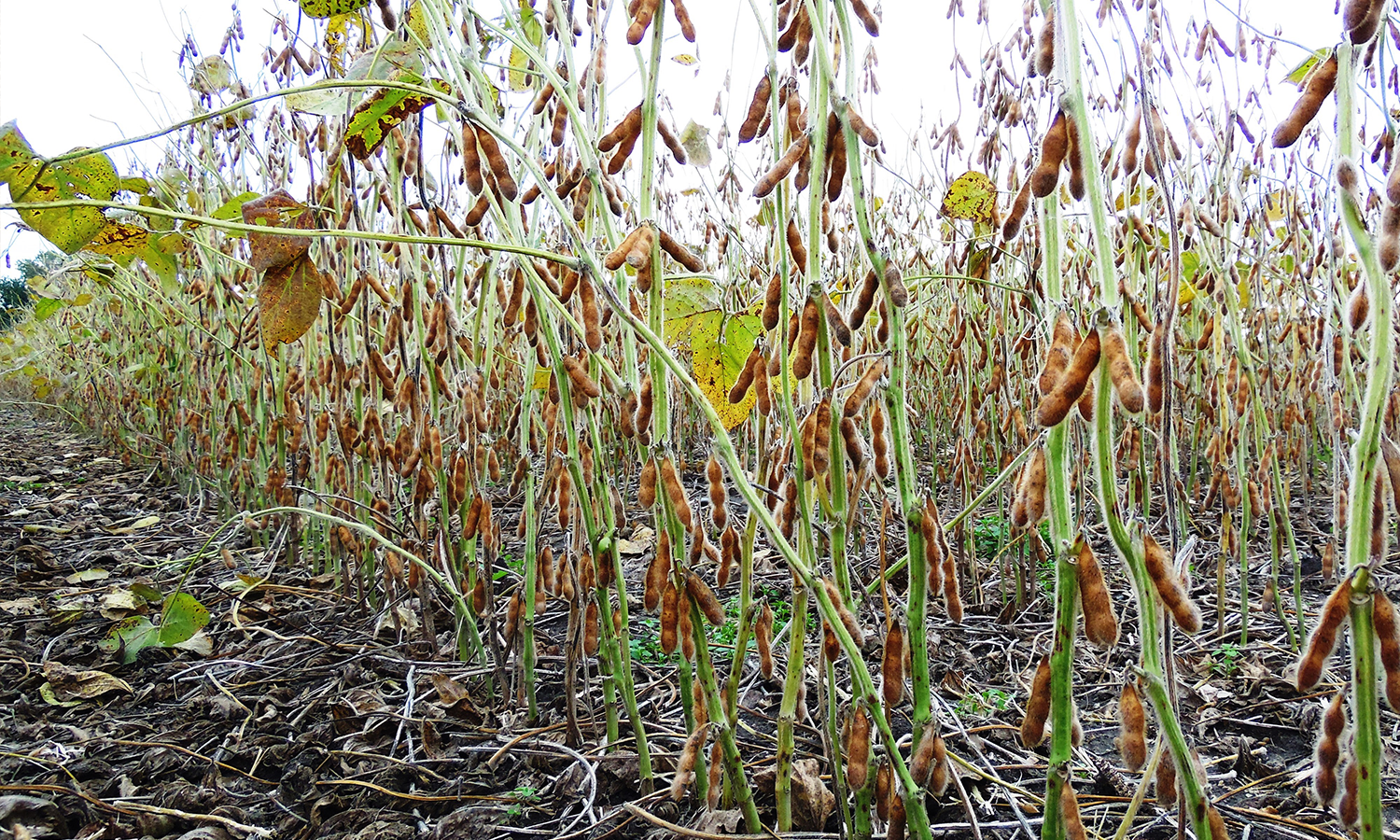Overcoming soybean harvest challenges in 2022 – lodging and green stems
Use this information to reduce soybean harvest losses due to green stems and lodging.

Due to the variable rainfall patterns that occurred across Michigan this summer, some soybean producers will likely face harvest challenges. The two most likely scenarios are lodging and green stems. The conditions that favor lodging are adequate to abundant rainfall or irrigation during the vegetative and early reproductive growth stages. Green stems typically develop when dry conditions during pod set and early pod fill are followed by adequate rain and good growing conditions later in the season. The parts of the state where I expect the stems to stay green are the Saginaw Valley and Thumb area.
Proper cutter bar maintenance, slower ground speeds and harvesting at a slight angle to the rows are recommended when faced with lodged plants or plants with green stems. Specific recommendations for each condition are provided below.
Recommendations for harvesting lodged plants
- Position the cutter bar as close to the ground as possible.
- Angle the pickup fingers on the reel back slightly to more aggressively pull the lodged plants to the cutter bar. Reduce the angle of the fingers if the plants are riding over the top of the reel.
- Move the reel axle forward so that it is 9-12 inches ahead of the cutter bar.
- Contact the manufacturer for specific recommendations if using an air-assisted reel in lodged soybeans. Moving the reel forward to pick up lodged plants decreases the performance of air-assisted reels. Pivot the down tubes above the crop if this option is available or remove the entire air manifold and drop tube assembly.
- Operate the reel as low as necessary to pick up lodged plants without causing them to ride over the top of the reel. Raise the reel if this happens.
- Install vine lifters on the cutter bar in conditions of severe lodging.
- When the plants are lodged in one direction, use vine lifters and harvest on an angle to the rows. Alternatively, harvest the lodged plants traveling opposite to direction they are leaning.
- Increase the reel speed relative to the ground speed. It may be challenging to maintain the correct ground and reel speed combination in lodged beans with brittle pods. When ground speed is too fast relative to reel speed, the cutter bar will ride over some plants. When the reel speed is too fast relative to ground speed, the reel may shatter the pods. The reel should run 10 to 20% faster than ground speed under ideal conditions. However, in lodged beans, increase the reel speed incrementally up to a maximum of 50% faster than the ground speed. If the reel is shattering pods, decrease the reel speed to the point when the shattering stops. If the cutter bar rides over lodged plants, decrease your ground speed.
Recommendations for harvesting plants with green stems

- Continue to harvest soybeans having green stems even though it requires slower travel speeds and closer attention to cutter bar maintenance, and reel and threshing adjustments. Waiting for the stems to dry down will lead to large shatter losses.
- If shatter losses are excessive, consider combining earlier in the morning or later into the evening when the pods have regained some moisture and are less brittle. However, this may increase plugging problems.
- Reduce your ground speed to three mph or less if necessary. This will reduce shatter losses and plugging at the cutter bar by providing a crisp sideways cut.
- Harvest at a 20 to 25 degree angle to the rows. This will improve cutter bar performance and provide more even feeding of the crop into the threshing cylinder or rotor. This may be the single most beneficial practice.
- Draper heads should also reduce plugging problems when harvesting soybeans with green stems as they provide more uniform feeding into the threshing cylinder or rotor.
- If the cutter bar is plugging, inspect and repair all identified problems. If the knife sections are sharp and tight, look for worn or rounded guards and replace them. Check that the speed of the knife is correct and that drive mechanisms such as belts are not slipping. Make sure that the knife is in proper register with the guards. Rotate the knife through one complete cycle and make sure that the tip of the knife sections are centered on a guard at the beginning of a cycle and end up centered on a guard at the end of the cycle.
- According to Gary Huitink, former agricultural engineer with the University of Arkansas, improper reel speed and reel position cause more shatter losses than any other maladjustment. Maintain the reel speed at 10 to 25% faster than the ground speed. Generally, positioning the reel as close to the auger as possible promotes even feeding into the combine. The height of the reel should be adjusted so that it contacts the top one third of the plants.
- Threshing problems result from worn parts on the cylinder or rotor and improper cylinder or rotor clearance or speed settings. The threshing equipment must be in good condition to handle soybeans with green/tough stems. Adjustments made to the cylinder/rotor clearance and speed is a balancing act between threshing losses and seed damage and split beans. Make one adjustment at a time and inspect the clean grain tank to determine your progress toward minimizing threshing losses and maximizing seed quality.
Soybean producers should apply the recommendations provided in this article, in your operator’s manual and by your local equipment dealer to reduce soybean harvest losses in 2022. Make one adjustment at a time and frequently stop to evaluate your progress in reducing gathering losses.
This article was produced by a partnership between Michigan State University Extension and the Michigan Soybean Committee.



 Print
Print Email
Email




